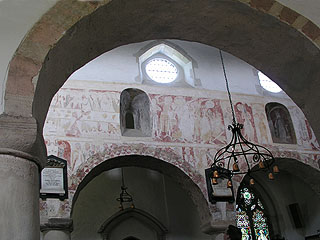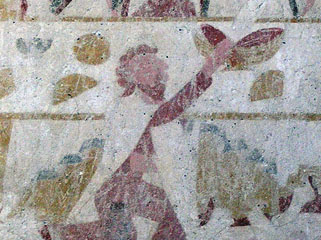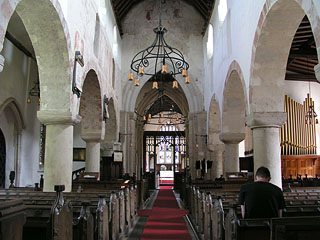Ickleton is one of the splendours of Cambridgeshire. Not that you'd notice from the outside, particularly. There's a central tower with a spire, but while that's unusual, it's hardly very exciting. The west door is a pleasant if somewhat severe Norman affair, with a Perpendicular window over it. In the porch is some nice groin vaulting. Little seems unusual, though aside from the height and narrowness of the nave.
Inside, though, we find something rather wonderful. The core of the nave is almost entirely Norman, as is the crossing and some of the south transept. Squat round pillars with cushion-like capitals form the arcades, looking (as Simon Jenkins notes) for all the world like something from central Italy.
Until recently it was thought that the pillars were Roman, reused from a villa found in the parish. Nowadays the consensus is that they're probably Saxon, and reused when the current building was started around 1100.
The Tuscan analogy is yet more suitable given that the wall above the north arcade is filled with the most wonderful 12th century wall paintings. These were only discovered in 1979 when a fire swept through the church, and it was decided to clean the walls.
We are very lucky that they did, for such early wall paintings are extremely rare in the UK - all the more so because the fresco technique used is one that tended to degenerate fast in the English climate.
They are faded (the guidebook tells us that what we see now is almost all the undercoat, and that we have lost the details of faces and so on) but vivid. The scheme of decoration is in two parts. Between the arches of the nave arcades are a number of martyrdoms - a good St Andrew in the middle, and rather more obscured images of St Peter and St Lawrence to either side.
Above these, between the openings of the Norman clerestory (which has been superceded by a later one on top, but is itself painted in the splays) are a sequence of paintings from the Passion. From west to east, these are the Last Supper, the Betrayal in the Garden, the Flagellation and an image of Christ carrying the cross. It is all quite magnificent.
The 14th century doom above the tower arch looks pale by comparison. Still, it is an interesting one, and would be the most interesting feature in many churches. Unusually, it shows the Virgin baring her breasts in supplication to Christ the judge, interceding for sinners at the Last Judgement. This sort of imagery was particularly disliked by the Early Modern iconoclasts, and so it too is a rare survival.
The rest of the church is worth a quick look. The Early English transepts have been much restored and the chancel was rebuilt in the 1880s.
The Perpendicular rood screen is original, and retains some of its colour. It also has the original gates, by the look of it.
A few late medieval poppy heads survive on bench ends - a particularly nice one shows St Michael weighing souls.
St Mary Magdalene was open when we visited




